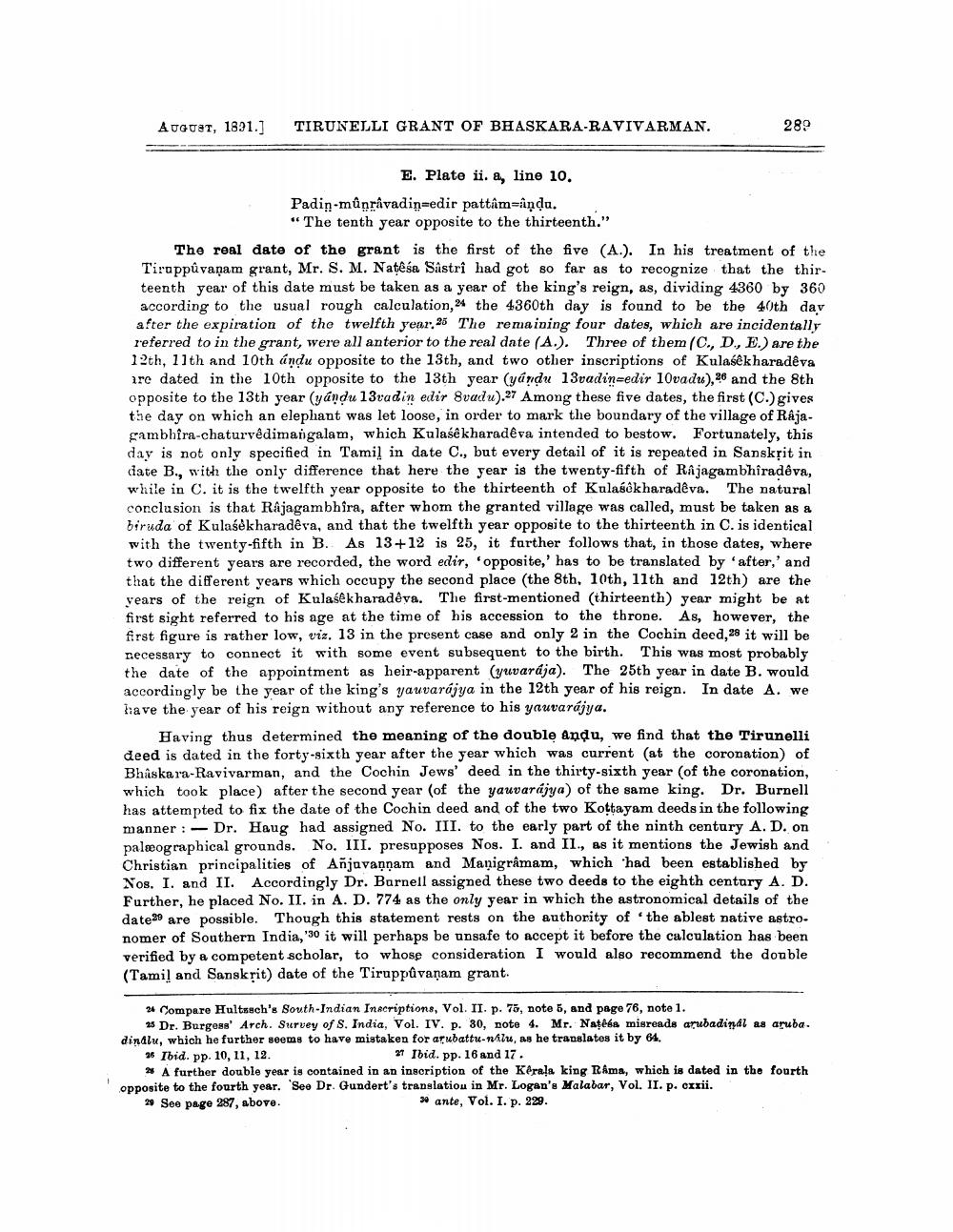________________
AUGUST, 1891.]
TIRUNELLI GRANT OF BHASKARA-RAVIVARMAN.
E. Plate ii. a, line 10.
Padin-mûnrâvadin-edir pattâm=ânḍu.
"The tenth year opposite to the thirteenth."
-
289
The real date of the grant is the first of the five (A.). In his treatment of the Tirappûvanam grant, Mr. S. M. Națêsa Sâstrî had got so far as to recognize that the thirteenth year of this date must be taken as a year of the king's reign, as, dividing 4360 by 360 according to the usual rough calculation, the 4360th day is found to be the 40th day after the expiration of the twelfth year.25 The remaining four dates, which are incidentally referred to in the grant, were all anterior to the real date (A.). Three of them (C., D., E.) are the 12th, 11th and 10th ándu opposite to the 13th, and two other inscriptions of Kulasekharadêva are dated in the 10th opposite to the 13th year (yundu 13vadin-edir 10vadu), 26 and the 8th opposite to the 13th year (yandu 13vadin edir 8vadu).27 Among these five dates, the first (C.) gives the day on which an elephant was let loose, in order to mark the boundary of the village of Rajagambhira-chaturvêdimangalam, which Kulasekharadeva intended to bestow. Fortunately, this day is not only specified in Tamil in date C., but every detail of it is repeated in Sanskrit in date B., with the only difference that here the year is the twenty-fifth of Rajagambhiraḍêva, while in C. it is the twelfth year opposite to the thirteenth of Kulasekharadêva. The natural conclusion is that Râjagambhira, after whom the granted village was called, must be taken as a biruda of Kulasekharadêva, and that the twelfth year opposite to the thirteenth in C. is identical with the twenty-fifth in B. As 13+12 is 25, it further follows that, in those dates, where two different years are recorded, the word edir, 'opposite,' has to be translated by 'after,' and that the different years which occupy the second place (the 8th, 10th, 11th and 12th) are the years of the reign of Kulasekharadeva. The first-mentioned (thirteenth) year might be at first sight referred to his age at the time of his accession to the throne. As, however, the first figure is rather low, viz. 13 in the present case and only 2 in the Cochin deed, 28 it will be necessary to connect it with some event subsequent to the birth. This was most probably the date of the appointment as heir-apparent (yuvarája). The 25th year in date B. would accordingly be the year of the king's yauvarajya in the 12th year of his reign. In date A. we have the year of his reign without any reference to his yauvarajya.
Having thus determined the meaning of the double andu, we find that the Tirunelli deed is dated in the forty-sixth year after the year which was current (at the coronation) of Bhaskara-Ravivarman, and the Cochin Jews' deed in the thirty-sixth year (of the coronation, which took place) after the second year (of the yauvarajya) of the same king. Dr. Burnell has attempted to fix the date of the Cochin deed and of the two Kottayam deeds in the following manner: Dr. Haug had assigned No. III. to the early part of the ninth century A. D. on paleographical grounds. No. III. presupposes Nos. I. and II., as it mentions the Jewish and Christian principalities of Añjuvanṇam and Manigramam, which had been established by Nos. I. and II. Accordingly Dr. Burnell assigned these two deeds to the eighth century A. D. Further, he placed No. II. in A. D. 774 as the only year in which the astronomical details of the date29 are possible. Though this statement rests on the authority of the ablest native astronomer of Southern India, '30 it will perhaps be unsafe to accept it before the calculation has been verified by a competent scholar, to whose consideration I would also recommend the double (Tamil and Sanskrit) date of the Tiruppavanam grant.
24 Compare Hultssch's South-Indian Inscriptions, Vol. II. p. 75, note 5, and page 76, note 1.
25 Dr. Burgess' Arch. Survey of S. India, Vol. IV. p. 30, note 4. Mr. Natêéa misreads arubadinál as aruba. dinálu, which he further seems to have mistaken for arubattu-nilu, as he translates it by 64.
25 Ibid. pp. 10, 11, 12.
27 Ibid. pp. 16 and 17.
28 A further double year is contained in an inscription of the Kerala king Râma, which is dated in the fourth opposite to the fourth year. See Dr. Gundert's translation in Mr. Logan's Malabar, Vol. II. p. cxxii. 30 ante, Vol. I. p. 229.
29 See page 287, above.




